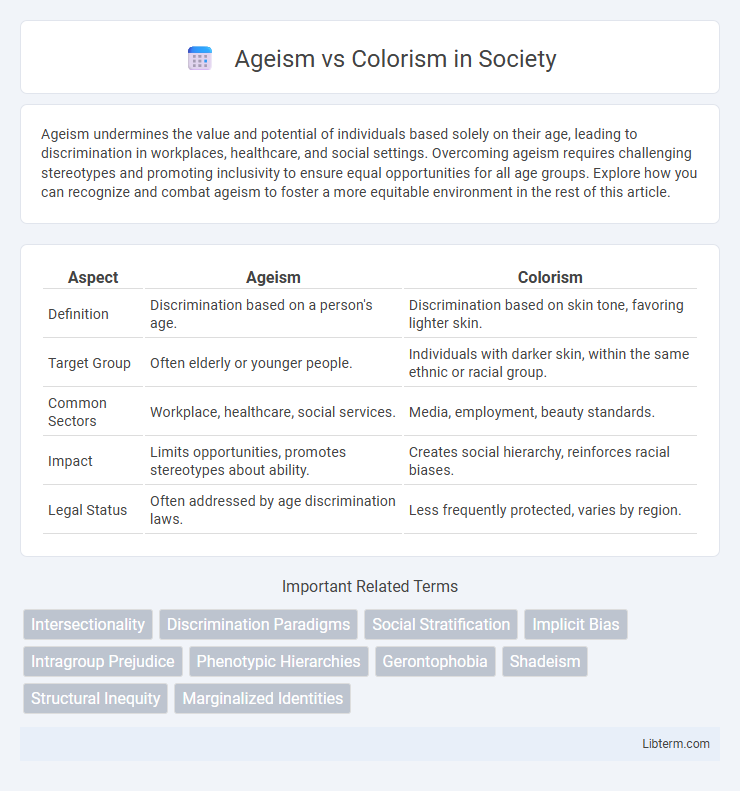Ageism undermines the value and potential of individuals based solely on their age, leading to discrimination in workplaces, healthcare, and social settings. Overcoming ageism requires challenging stereotypes and promoting inclusivity to ensure equal opportunities for all age groups. Explore how you can recognize and combat ageism to foster a more equitable environment in the rest of this article.
Table of Comparison
| Aspect | Ageism | Colorism |
|---|---|---|
| Definition | Discrimination based on a person's age. | Discrimination based on skin tone, favoring lighter skin. |
| Target Group | Often elderly or younger people. | Individuals with darker skin, within the same ethnic or racial group. |
| Common Sectors | Workplace, healthcare, social services. | Media, employment, beauty standards. |
| Impact | Limits opportunities, promotes stereotypes about ability. | Creates social hierarchy, reinforces racial biases. |
| Legal Status | Often addressed by age discrimination laws. | Less frequently protected, varies by region. |
Understanding Ageism: Definition and Origins
Ageism refers to discrimination or prejudice against individuals based on their age, often targeting older adults and sometimes younger people in social and professional settings. Originating from societal stereotypes and cultural norms that value youthfulness and productivity, ageism manifests through exclusion, stereotyping, and unequal treatment in employment, healthcare, and media representation. Understanding ageism involves recognizing its deep-rooted biases and the impact on individuals' rights, social inclusion, and mental health.
What is Colorism? A Historical Perspective
Colorism is a form of discrimination based on skin tone, often privileging lighter skin over darker shades within the same racial or ethnic group. Historically, colorism emerged during colonialism and slavery when lighter skin was associated with higher social status, closer proximity to European ancestry, and greater economic opportunities. This systemic bias has perpetuated social hierarchies and internalized prejudice, impacting everything from employment to cultural representation.
Ageism vs Colorism: Key Differences
Ageism involves discrimination based on a person's age, often targeting older or younger individuals, while colorism refers to prejudice against people with darker skin tones within the same racial or ethnic group. Ageism impacts opportunities in employment, healthcare, and social participation, whereas colorism affects social status, beauty standards, and economic advantages. Both forms of bias perpetuate inequality but operate through distinct societal mechanisms and affect different demographic characteristics.
Societal Impact of Ageism
Ageism contributes significantly to social exclusion, limiting opportunities for older adults in employment, healthcare, and social participation. It perpetuates stereotypes that devalue aging populations, leading to decreased self-esteem and mental health challenges among the elderly. This systemic bias reinforces economic disparities and challenges intergenerational solidarity within communities.
The Harmful Effects of Colorism
Colorism perpetuates discrimination based on skin tone, often privileging lighter skin within the same racial or ethnic group, which exacerbates social inequality and psychological distress. Victims of colorism face limited opportunities in employment, education, and social mobility, reinforcing systemic biases and economic disparities. The internalization of colorist attitudes can damage self-esteem and mental health, leading to lasting emotional and societal harm.
Intersectionality: When Ageism and Colorism Overlap
Ageism and colorism intersect to create compounded discrimination affecting individuals, particularly older people of color who face biases based on both age and skin tone. This intersectionality intensifies social exclusion, limits economic opportunities, and perpetuates stereotypes that marginalize these groups within various cultural and professional contexts. Understanding how ageism and colorism overlap is crucial for developing inclusive policies that address multiple layers of systemic inequality simultaneously.
Media Representation: Shaping Age and Skin Tone Perceptions
Media representation plays a crucial role in shaping societal perceptions of ageism and colorism by often prioritizing youthful and lighter-skinned individuals in advertising, television, and film. This selective visibility reinforces harmful stereotypes, marginalizing older adults and darker-skinned people, thereby perpetuating prejudices and limiting diverse portrayals. Studies reveal that inclusive media representation can challenge these biases, promoting acceptance and equity across age and skin tone variations.
Systemic Discrimination: Policies and Practices
Systemic discrimination manifests in both ageism and colorism through institutional policies and practices that marginalize specific groups. Ageism enforces mandatory retirement ages and limits career advancement for older employees, perpetuating economic and social exclusion. Colorism embeds biases within hiring, housing, and education systems, privileging lighter skin tones and reinforcing disparities in wealth, health, and opportunity.
Combating Ageism and Colorism in Everyday Life
Combating ageism and colorism in everyday life involves actively challenging stereotypes and biases related to age and skin color through inclusive language and behavior. Promoting diverse representation in media, workplaces, and social spaces helps break down prejudices and fosters acceptance. Engaging in open conversations and educating others about the harmful impacts of ageism and colorism encourages empathy and systemic change.
Building Inclusive Futures: Solutions and Advocacy
Addressing ageism and colorism requires targeted policies that promote equity in workplaces, education, and media representation. Advocacy efforts emphasizing intersectionality foster understanding of how overlapping biases impact marginalized communities, creating a framework for inclusive futures. Implementing diversity training and enforcing anti-discrimination laws are critical steps to dismantle systemic barriers and cultivate environments where all identities are valued.
Ageism Infographic

 libterm.com
libterm.com